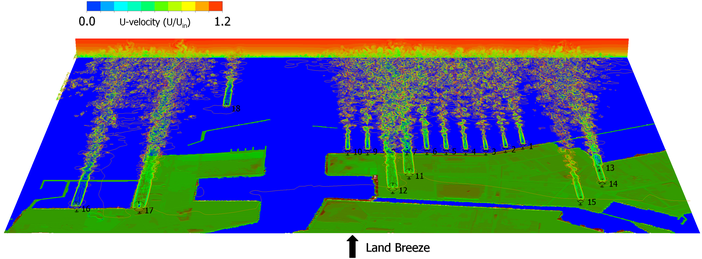研究成果 Research Results
- TOP
- News
- Research Results
- Better evaluating bankability of large-scale offshore wind farms
Better evaluating bankability of large-scale offshore wind farms
New wind turbine wake model takes into account effects of wind speed loss region 2020.09.02Research ResultsPhysics & ChemistryEnvironment & Sustainability

An example of numerical simulations of the relative wind velocity at a wind farm using the newly developed porous disk computational fluid dynamics wake model. The blue areas indicate the sea.
Newly reported modeling that includes downstream changes in wind caused by wind turbines will aid in the pre-construction evaluation of wind farms to more accurately assess the bankability of large-scale wind energy projects.
Developed by Takanori Uchida, associate professor of Kyushu University’s Research Institute for Applied Mechanics (RIAM), the model takes into account a wind speed loss region called wind turbine wake that is formed on the downstream side of a rotating wind turbine blade.
Even with a single wind turbine, the flow phenomena inside the wind turbine wake are extremely complex. An understanding of these phenomena is critical for large-scale offshore wind farms consisting of multiple wind turbine groups since wake from multiple turbines interfere with each other and have a direct impact on downstream groups.
Specifically, the wake can cause a decrease in the amount of power generated, and it can also be associated with a sudden breakdown or accident inside or outside the wind turbines. Therefore, prior to construction, it is necessary to predict the behavior of the wind turbine wake formed by each wind turbine and its mutual interference phenomenon, and to carry out durability evaluation of each wind turbine and economic evaluation of entire wind farms, which are being studied in coastal areas throughout Japan.
The new wind turbine wake model developed by Uchida for general-purpose use contributes to the evaluation of bankability of large-scale offshore wind farms by incorporating wake using a computational fluid dynamics porous disk model. This modeling will help to guide the design of wind farms and better predict the economic outcome of large-scale projects.
###
For more information about this research, see “A new wind turbine CFD modeling method based on a porous disk approach for practical wind farm design”, Takanori Uchida, Yoshihiro Taniyama, Yuki Fukatani, Michiko Nakano, Zhiren Bai, Tadasuke Yoshida, and Masaki Inui, Energies, 13 (12), 3197, 2020. https://doi.org/10.3390/en13123197
This research is supported by joint research with Toshiba Energy Systems & Solutions Corporation and Hitachi Zosen Corporation. In addition, this work was supported by JSPS KAKENHI Grant Number 17H02053.
Research-related inquiries
Takanori Uchida, Associate Professor
Research Institute for Applied Mechanics (RIAM), Wind Engineering Section
Contact information can also be found in the full release.
- TOP
- News
- Research Results
- Better evaluating bankability of large-scale offshore wind farms































